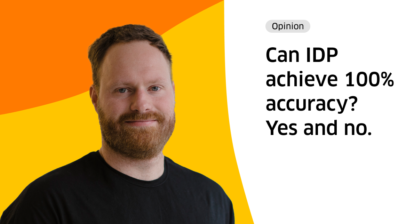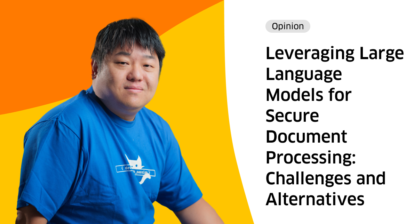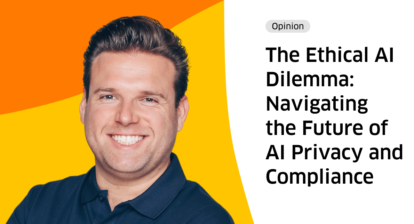Curious about what keeps experts, CEOs and other decision-makers in the Intelligent Document Processing (IDP) space on their toes? Get food for thought on IDP-related topics from the industry’s leading minds. In this opinion piece, Yeelen Knegtering, Co-Founder and CEO of IDP vendor Klippa, explains why the lines between IDP and RPA are blurring and what will be the differentiating factor among IDP vendors.
As we speak, the landscape of automation technologies is undergoing significant transformation. Thanks to the increasing accessibility of ready-to-use AI models, the lines between our fields of relevance – such as Intelligent Document Processing (IDP) and Robotic Process Automation (RPA) – are being blurred. While initially distinct, these sectors are witnessing a convergence driven by the democratization of AI technologies. The trend is reshaping how businesses approach automation, mainly based on the fact that integrating the right AI model can more efficiently streamline business operations.
Advancements in natural language processing and machine learning algorithms have significantly improved the capabilities of IDP systems, which now understand and process complex documents with greater accuracy and effectiveness than ever before. On the RPA front, AI integration has transformed bots from rule-based scripts that perform repetitive tasks into agents capable of understanding unstructured data, making decisions, and learning from outcomes. A convergence between the two complementary sectors is imminent.
Why is it happening
It all boils down to accessibility. As AI models are more accessible, they become easier to integrate into various platforms. This evolution bridges previously existing gaps, like the need to have a proper understanding of the technology to implement it for specific tasks. Nowadays, companies no longer need to heavily invest in custom solutions or possess deep expertise. Instead, they can just reach for a readily available model and have it quickly adapted to their business needs.
Ease of access to AI technologies is not only facilitating an IDP-RPA market but also creating a unified dynamic among us vendors. Since we are more and more enabled to offer standardized, easy-to-implement solutions, a shift from proprietary AI models to more universally accessible capabilities is undergoing. The merged market will thus be powered by comprehensive, scalable, and flexible options. More precisely, the kind that can quickly and simply automate both data extraction, as well as subsequent actions such as updating databases, initiating workflows, or communicating with customers.
OK, but how will we differentiate
Since accessible AI models are here to stay, the differentiating factor among IDP vendors will increasingly lie in the workflows and tooling surrounding data extraction and processing. The distinction between processing structured and unstructured data is not as relevant as it used to be. Seamless integration, user-friendly interfaces, customization options, and adaptiveness to unique business needs are all examples of what’s going to create success stories in the converged market. We need to be aware that the focus is increasingly shifting from the capabilities of the AI models themselves, to how they can be implemented within the broader context of business operations.
To put it simply, it’s getting less about AI technology and more about user experience and added value in terms of data management and process optimization. Vendors poised on offering sophisticated, yet highly flexible solutions are already gaining a competitive edge. A market where excellence in applying and integrating technology becomes as crucial – if not more – than the technology itself, is a good sign. It signals maturity. It suggests that the future leaders of this space will be those who not only harness cutting-edge AI, but also excel in making it accessible and beneficial across varied business environments.
What will the convergence look like
If we consider sheer size, the ongoing integration and overlapping of technologies suggest that IDP is becoming a niche within the larger RPA market. Some of the numbers out there indicate that the former is now roughly half the size of the latter. Projections, however, see the RPA market growing as much as seven times larger than IDP by the end of this decade. This indicates not only a shift in market dynamics but also a broader adoption and integration of RPA technologies across various sectors. As businesses increasingly recognize the value of automation in enhancing productivity and reducing costs, the demand for RPA solutions that incorporate intelligent document processing capabilities will continue to rise.
Businesses will adhere to comprehensive solutions, with the distinction between processing structured and unstructured data becoming less relevant. Instead, the focus shifts to the ability to automate a wide range of tasks: from simple data entry to complex document analysis within a single, cohesive framework. A more holistic approach to automation, where the synergy between IDP and RPA technologies can be leveraged to create more efficient, intelligent, and adaptable automation strategies. The integrated approach is set to redefine the automation landscape, pushing the boundaries of what can be achieved through digital transformation.

About the Author
Yeelen Knegtering is CEO and Co-Founder of Klippa, an international provider of intelligent document processing solutions serving more than 1000 companies worldwide. The organization also advocates for meaningful workplace automation. Klippa began the year by showcasing the innovative DocHorizon Platform at CES 2024 in Las Vegas.
📨Get IDP industry news, distilled into 5 minutes or less, once a week. Delivered straight to your inbox:







